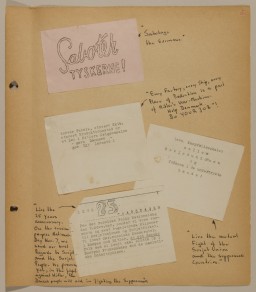You searched for: 批发产品投资理财源码快速搭建【TG���������@EK7676】平台包网搭建批发产品投资理财源码快速搭建【TG���������@EK7676】平台包网搭建2pT6oIvkLn
<< Previous | Displaying results 1-25 of 328 for "批发产品投资理财源码快速搭建【TG���������@EK7676】平台包网搭建批发产品投资理财源码快速搭建【TG���������@EK7676】平台包网搭建2pT6oIvkLn" | Next >>
-
Subsequent Nuremberg Proceedings, Case #2: The Milch Case
ArticleThe Milch Case was Case #2 of 12 Subsequent Nuremberg Proceedings against leading German industrialists, military figures, SS perpetrators, and others.
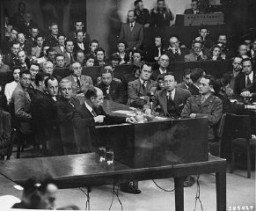
-
V-2 rockets
PhotoSections of V-2 rockets, the so-called Vengeance Weapons, are removed by rail from the Dora-Mittelbau camp after liberation. Near Nordhausen, Germany, June 1945.
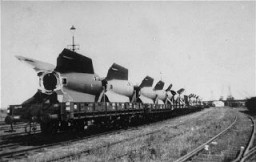
-
Page 2 of passport issued to Setty Sondheimer
DocumentSetty and Moritz Sondheimer and their two children fled Nazi Germany for Kovno, Lithuania, in 1934. There, Moritz opened a small factory manufacturing buttons and combs. This image shows page 2, containing an identification photograph, of a passport issued to Setty Sondheimer by the German Consulate in Kovno on January 29, 1938. With aid from Japanese diplomat Chiune Sugihara in obtaining Japanese transit visas, Setty and her family emigrated from Kovno in February 1941. [From the USHMM special exhibition…
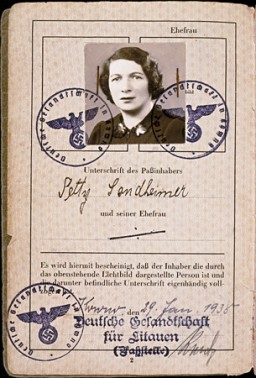
-
Page 2 of International Military Tribunal program
ArtifactSecond page of a list of defendants at the International Military Tribunal at Nuremberg. This material appears in a mimeographed program booklet distributed at the IMT. This page includes: Hans Frank, Ernst Kaltenbrunner, and Wilhelm Frick, along with brief biographical information for each.
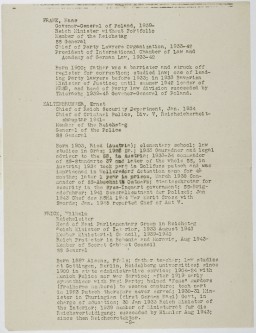
-
Page from volume 2 of a set of scrapbooks documenting the German occupation of Denmark
ArtifactPage from volume 2 of a set of scrapbooks compiled by Bjorn Sibbern, a Danish policeman and resistance member, documenting the German occupation of Denmark. Bjorn's wife Tove was also active in the Danish resistance. After World War II, Bjorn and Tove moved to Canada and later settled in California, where Bjorn compiled five scrapbooks dedicated to the Sibbern's daughter, Lisa. The books are fully annotated in English and contain photographs, documents and three-dimensional artifacts documenting all…
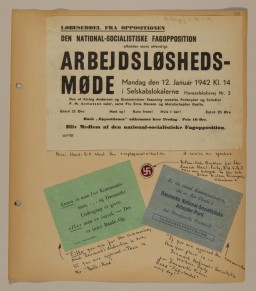
-
Poster: "We Women Are Voting Slate 2 National Socialists."
PhotoPoster: "We Women Are Voting Slate 2 National Socialists." German women were an important voting bloc. The Nazis made a concerted effort to appeal to women, as exemplified by this 1932 election poster. The Nazis had to repackage their messages to de-emphasize military aims. Hitler consciously modeled some Nazi propaganda appeals to German women on speeches delivered by Benito Mussolini in Fascist Italy, who also had to calm the fears of Italian war widows after World War I. Nazi propagandists attempted to…

-
Hitler Youth
ArticleThe Hitler Youth and the League of German Girls were developed as Nazi Party youth groups to indoctrinate children and youth in Nazi ideology and policy.
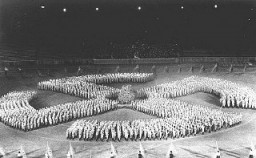
-
Magnus Hirschfeld
ArticleA leading researcher of sex, sexuality, and gender, German Jewish doctor Magnus Hirschfeld was forced to live in exile after the Nazi rise to power.
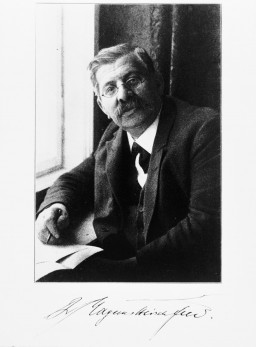
-
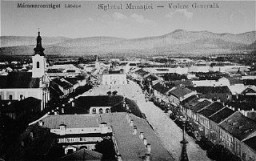
-
Headphones
ArtifactHeadphones used by defendant Albert Speer during the International Military Tribunal. Headphones like these enabled trial participants to hear simultaneous translation of the proceedings.
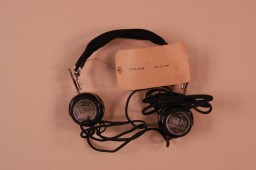
-
Book burning in Berlin
PhotoBooks and writings deemed "un-German" are burned at the Opernplatz (Opera Square). Berlin, Germany, May 10, 1933.
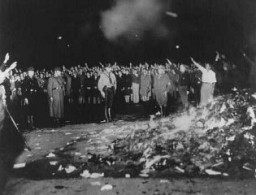
-
Arriving in New York
PhotoChildren aboard the President Harding look at the Statue of Liberty as they pull into New York harbor. They were brought to the United States by Gilbert and Eleanor Kraus. New York, United States, June 1939.

-
Conditions in the Warsaw ghetto
FilmThe Nazis sealed the Warsaw ghetto in mid-November 1940. German-induced overcrowding and food shortages led to an extremely high mortality rate in the ghetto. Almost 30 percent of the population of Warsaw was packed into 2.4 percent of the city's area. The Germans set a food ration for Jews at just 181 calories a day. By August 1941, more than 5,000 people a month succumbed to starvation and disease.
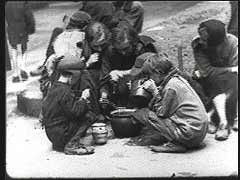
-
Hannah Szenes
PhotoHannah Szenes on her first day in Palestine. Haifa, Palestine, September 19, 1939. Between 1943 and 1945, a group of Jewish men and women from Palestine who had volunteered to join the British army parachuted into German-occupied Europe. Their mission was to organize resistance to the Germans and aid in the rescue of Allied personnel. Hannah Szenes was among these volunteers. Szenes was captured in German-occupied Hungary and executed in Budapest on November 7, 1944, at the age of 23.
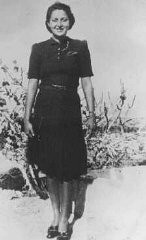
-
Armenian refugees
PhotoRefugees foraging at Alexandropol, Russian Armenia. Photograph taken by John Elder. In 1917, Elder, a divinity student from Pennsylvania, joined the American Committee for Armenian and Syrian Relief team that was aiding refugees. For two years, Elder did volunteer work with Armenian orphans. During that time, he photographed refugees and conditions at camps.
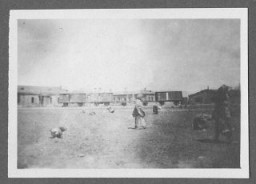
-
Belle Mayer Zeck describes working conditions and staffing at Nuremberg during the postwar trials
Oral HistoryBelle Mayer trained as a lawyer and worked for the General Counsel of the US Treasury, Foreign Funds Control Bureau. This bureau worked to enforce the Trading With the Enemy Act passed by Congress. In this capacity, Mayer became familiar with the German I. G. Farben chemical company, a large conglomerate that used slave labor during World War II. In 1945, Mayer was sent as a Department of Treasury representative to the postwar London Conference. She was present as representatives from the Allied nations…
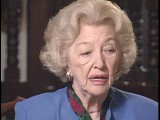
-
Edward Vebell courtroom sketch
ArtifactCourtroom sketch drawn during the International Military Tribunal by American artist Edward Vebell. The drawing's title is "German defense counsel -- they are immediately in front of the defendants." 1945.
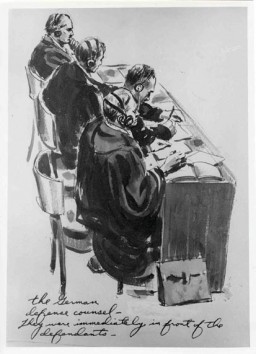
-
Deportation from the Warsaw ghetto
PhotoDeportation of Jews from the Warsaw ghetto during the ghetto uprising. The original German caption reads: "To the Umschlagplatz." Warsaw, Poland, May 1943.
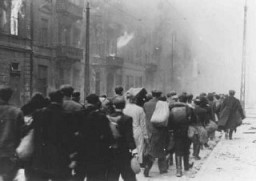
-
The Times, August 17, 1921
ArtifactIn this London Times article, reporter Philip Graves compared passages from Maurice Joly’s Dialogue in Hell Between Machiavelli and Montesquieu (1864) side-by-side with the Protocols of the Elders of Zion in order to prove that the Protocols was plagiarized. Other investigations revealed that one chapter of a Prussian novel, Hermann Goedsche’s Biarritz (1868), also “inspired” the Protocols. Times (London), August 17, 1921.
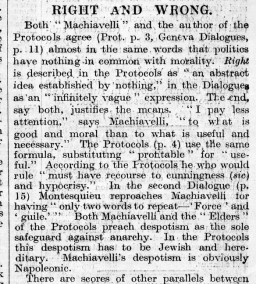
-
Demonstrating the operation of the Dachau crematorium
PhotoSurvivors of the Dachau concentration camp demonstrate the operation of the crematorium by pushing a corpse into one of the ovens. Dachau, Germany, April 29–May 10, 1945. This image is among the commonly reproduced and distributed, and often extremely graphic, images of liberation. These photographs provided powerful documentation of the crimes of the Nazi era.
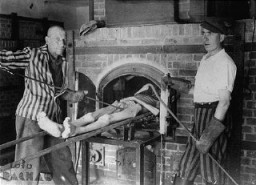
-
Scene during the building of Schindler's factory
PhotoConstruction of Oskar Schindler's armaments factory in Bruennlitz. Czechoslovakia, October 1944.
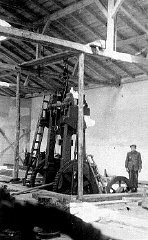
-
Booklet about International Military Tribunal
ArtifactFirst page of a program booklet distributed during the International Military Tribunal at Nuremberg. The dramatic text sets the scene in the courtroom.
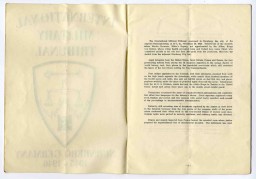
-
Matchbox cover with Japanese propaganda illustration
ArtifactDuring the war the Japanese flooded Shanghai with anti-American and anti-British propaganda, including this image from a matchbox cover. It depicts a Japanese tank rolling over the U.S. and British flags. Shanghai, China, between 1943 and 1945. [From the USHMM special exhibition Flight and Rescue.]
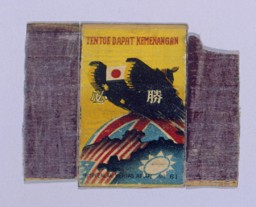
-
View of Rotterdam after German bombing in May 1940
PhotoView of Rotterdam after bombing by the German Luftwaffe in May 1940. Rotterdam, the Netherlands, 1940.
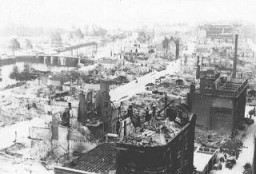
-
Page from volume 5 of a set of scrapbooks documenting the German occupation of Denmark
ArtifactPage from volume 5 of a set of scrapbooks compiled by Bjorn Sibbern, a Danish policeman and resistance member, documenting the German occupation of Denmark. Bjorn's wife Tove was also active in the Danish resistance. After World War II, Bjorn and Tove moved to Canada and later settled in California, where Bjorn compiled five scrapbooks dedicated to the Sibbern's daughter, Lisa. The books are fully annotated in English and contain photographs, documents and three-dimensional artifacts documenting all…
